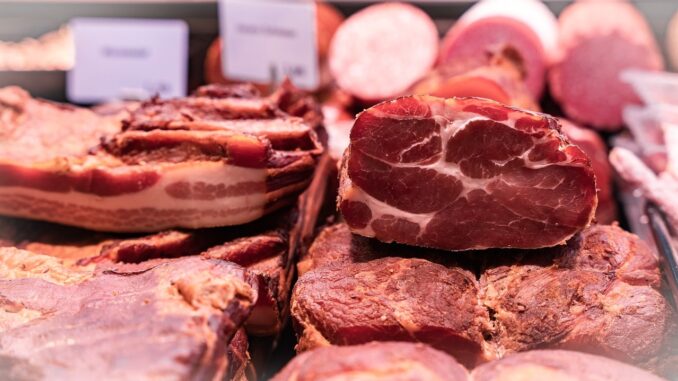
With the high price of meat, here are 36 ways to save on your meat purchases.
1: Buy a good cookbook. Familiarize yourself with cheaper meat cuts.
2: Have at least one meatless day each week – serve substitutes.
3: Trade budget-stretching meat recipes with friends, neighbors, relatives.
4: Avoid expensive canned and frozen “convenience” meats.
5: Watch ads & stock up on genuine meat bargains. Keep your freezer full.
6: Buy meats in economy “family-packs” when possible. Divide and freeze for specific uses.
7: Stretch hamburger meat by adding bread crumbs, chopped onion, egg and seasonings. Shape into patties and grill.
8: Buy beef by the “half” or “quarter”. Have it professionally cut and store in your freezer. Sell or trade excess with your neighbors.
9: To avoid excessive shrinkage and waste, cook long-cooking meat over low or moderate heat or in 325 degree oven.
10: Use a meat thermometer to determine doneness. This prevents overcooking, shrinkage and drying out of meat.
11: Well trimmed meat weights less, costs less. Shop around and find the markets that do the best trimming job.
12: Extend meat loaf and other ground-beef dishes with mixed vegetables, mashed white or sweet potatoes, rice or pasta.
13: Reduce amount of meat in such recipes as stews, casseroles, chili and spaghetti sauce. Increase sauce and vegetable.
14: For freshest meats, shop early on days when stores are busy – generally mid to end of week. Avoid mornings after long weekends.
15: Stir-frying stretches meat and it’s fast too. To cut into thinnest slices, partially freeze the meat. Use round and flank steaks.
16: Use “chunky” style soups over potatoes or pasta in place of meat.
17: Substitute small bone chuck steak for sirloin or top round. Sprinkle with meat tenderizer before broiling or barbecuing.
18: Rush purchased meat to refrigerator or freezer to avoid spoilage.
19: To avoid wasting hamburger, freeze as patties instead of as a chunk.
20: Save tough rinds from ham, bacon or hocks. Tuck into potato, rice or noodle casseroles & bake for meat flavor. Discard before serving.
21: Unless you want the bone for soup, a boneless ham usually costs less.
22: Save & freeze all meat bones and trimmings. Use in soups and stews.
23: Buy large cuts of meat (chuck & pork roasts; thick steaks & ham), when on sale and cut up for a variety of uses.
24: Marinate, tenderize or braise less tender cuts of meat before cooking.
25: Try less expensive “organ” meats: liver, heart, brains, kidney, tripe.
26: Buy luncheon meats unsliced in a chunk. Slice them yourself & save.
27: Buy bacon ends in economy sizes; divide and freeze. Cook, then combine with scrambled eggs – much cheaper than perfectly sliced bacon.
28: Get acquainted with your market’s meat cutter. He can alert you to unadvertised specials and give you good cooking and saving tips.
29: Slice roasts and ham thin. Two thin slices look like more on the place than one thick one.
30: You require less ground-meat mixture per serving if you use it to stuff tomatoes, green peppers, cabbage leaves and any type of squashes.
31: To avoid “freezer burn”, which dries out and toughens meat, rewrap all market-packaged meats in airtight freezer wrap.
32: Save cooking liquid from New England boiled dinner, smoked pork shoulder or brisket. Use for lentil, pea, potato or barley soup.
33: Save all scraps of meat leftovers. Then grind or chop them & mix with salad dressing, relish, celery & onion for sandwich spreads and dips.
34: Make gravy from drippings. Serve on biscuits, toast, pasta, rice, etc.
35: Dice cooked meat leftovers, mix with barbecue sauce & serve in buns.
36: Save on “outdated” meats, but freeze or serve as soon as possible.
Do you eat a lot of meat? Which one of these suggestions do you like best?
Let us know in the comments below!

Be the first to comment